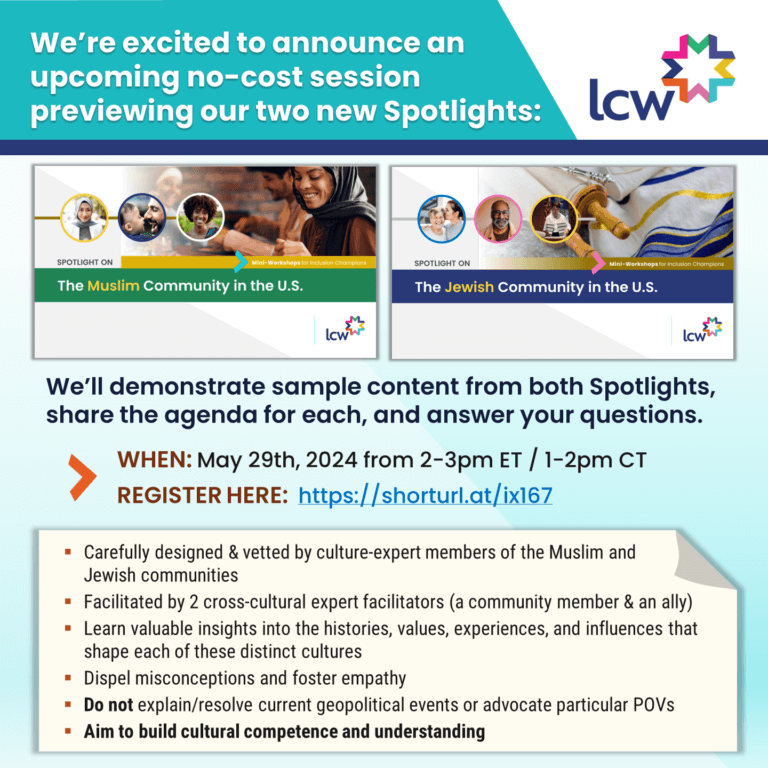
By Jeffrey Cookson, GPHR, SPHR, Executive Coach & Master Facilitator, LCW
A verdict has been reached in the trial of Derek Chauvin, the former Minneapolis police officer accused of murdering George Floyd. No matter the outcome, experience tells us that this discussion is far from over. In fact, it will remain top-of-mind for many of us – especially communities of color.
You may be grappling with how to manage this conversation – one that’s bound to spark extremely strong opinions and emotions – within your organization and your community at large. Below are a few resources to help you navigate conversations about the verdict inside your organization and beyond:
- Courageous Conversation Starter Kit
- Formal Statement Considerations
- Considerations when Speaking with Employees, Customers, their Families and Communities
- Additional Resources & Articles
Courageous Conversations Starter Kit
- Open the conversation with vulnerability. Share as a leader how you are personally feeling about events this week, keeping in mind that people might have a context different from your own.
- Acknowledge what is happening, the pain, the hurt, the anger, the surprise – the full range of emotions. Try one or more of the following:
- “As inclusive leaders—It is our responsibility to address and explicitly name the tension and pain we feel in the world….”
- “We believe in creating compassionate space for uncomfortable conversations. Let me say, today I am reflecting on…”
- “As a human being, today I am reflecting on…”
- “This has impacted me personally because…”
- “Racial equity begins with our own introspection around privilege, and today I am reflecting on…”
- “The communities historically most impacted by police violence have a variety of responses that I’m processing, including…”
- Reinforce your company values. Emphasize your commitment to a working environment that promotes diversity and equal opportunity, where there is mutual trust and respect for human rights. These values and principles unite us in moral decency and human compassion.
- Allow the space for team members to share. No one should be forced to share. Some will want to share, while other people may not want to share in a team setting. Remind your team that you are always available to talk if they prefer to discuss anything one-on-one.
- Practice active listening, and set the tone for showing support and being there.
Formal Statement Considerations
Points and questions to consider as you and your organization reflect on the verdict externally:
- With whom and for what do you stand in solidarity and against? How can you validate that?
- In what concrete ways do you and your organization support meaningful and lasting change leading to racial equity?
- How are you and your organization formally and informally making space internally for brave conversations about race, policing, criminal justice, and other relevant needs and concerns?
- How are you and your organization proactively supporting related employee needs and concerns?
- What if any connections do you or the organization make between needed reforms in policing and criminal justice and changes needed to drive equity regarding, for example, healthcare, education, housing, employment, safety in the public square, healthy food and clean water and, expanding access to voting?
- What changes in public policy do you and the organization believe need to be made and why?
Considerations when Speaking with Employees, Customers, their Families and their Communities
Points and questions to consider to guide conversations with these critical stakeholders:
- What do you or the organization think the verdict implies about the policing and criminal justice systems in the US?
- How can you or your organization make sense and meaning of the verdict response from families and communities impacted by unnecessary and unwarranted police violence?
- How can you or your organization appeal for peace and calm in a way that demonstrates empathy and validates people and communities deeply and historically impacted by unnecessary and unwarranted police violence?
- How can you or your organization validate and make space for people to process the full scope of human emotions in ways that support individual and collective healing, without asking anyone to process their grief or other feelings publicly?
- How can you help those who are not part of communities historically impacted by police violence be more understanding of, and express greater empathy for, those from the most impacted communities (especially when the former group expresses dismay at reactions from the most impacted communities)?
Additional Resources & Articles
- Your Organization’s Employee Assistance Program
- Center for Policing Equity
- Just Capital
- George Floyd Justice in Policing Act
- Notable corporate responses to the George Floyd protests that provide examples of organizational commitments
- How Organizations Can Support the Mental Health of Black Employees
- 7 Ways to Support Black Employees
- 4 Thing Managers Should – And Shouldn’t – Do to Address this Moment of Racial Reckoning
- 3 Ways Leaders Can Lead Office Conversations on Racism, Justice
- How Employers Can Help Workers Cope with Social Unrest
- How U.S. Companies Can Support Employees of Color through the Pandemic
- What Black Employee Resource Groups Need Right Now
- Facing the Divide: Psychology’s Conversation on Race and Health; Related Video
- 5 Ways to Support Employees and Managers Amid Political and Social Unrest


